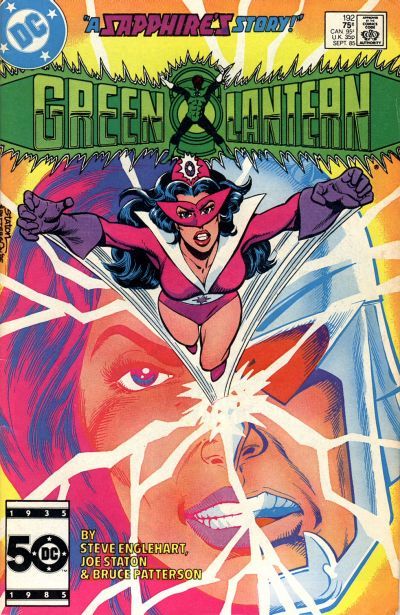
Green Lantern #192 Sept 1985
“First Star I See Tonight”
Steve Englehart
Joe Staton
Bruce D. Patterson
This was Steve Englehart’s masterpiece. Maybe not in terms of quality (although I’d put it Top 5), but certainly in Degree of Difficulty.
It was a difficulty he brought upon himself, and probably would gladly do so again. From the start of his career he was a character-first writer, always decided where he wanted to go with the hero before deciding who they’d fight. (Standard procedure today but unique in the day, except for the occasional “A very special issue.”) That’s why continuity and character history was such a huge component of his work. Here the task wasn’t so much Green Lantern as his love interest, Carol Farris, reconciling her conflicting personalities over the course of the title. Taking over in the middle of Len Wein’s run, his other task was identifying the Predator, a masked, particularly vicious villain. He combined the two to brilliant effect. In fact, the issue before, Green Lantern #191, Pharozonk’s choice yesterday, accomplishes this with one of the most shocking endings/cliffhangers ever.
But it’s the next issue, the explanation, the flashbacks, all laid out like the final scene of a mystery, that stands out to me. If it had it been the work of a single writer, that alone would have been enough for it to be hailed as ingenious. Considering the building blocks were the work of different writers over the course of decades, it becomes an even bigger accomplishment.
But not the greatest accomplishment of the issue. Allow me to introduce Joe Staton, a man whose work over the years has been on occasion labeled as too cartoony (Somewhat unfairly because his pencils varied greatly with each inker.). This was his
tour de force. Englehart’s flashbacks allowed Staton to work in the style of previous greats. Already having ghosted Gil Kane--I believe on Spider-Man--he was an excellent mimic and up to the task. He also got to do Mike Grell, Alex Saviuk, and even his earlier self. (And maybe Dave Gibbons, my memory is spotty on that one.) A great script would have lost quite a lot in translation if illustrated by anyone else.
And also of note, Englehart took over the letter column to explain--with justified pride--how this issue came to be. It’s a great compliment to the story.